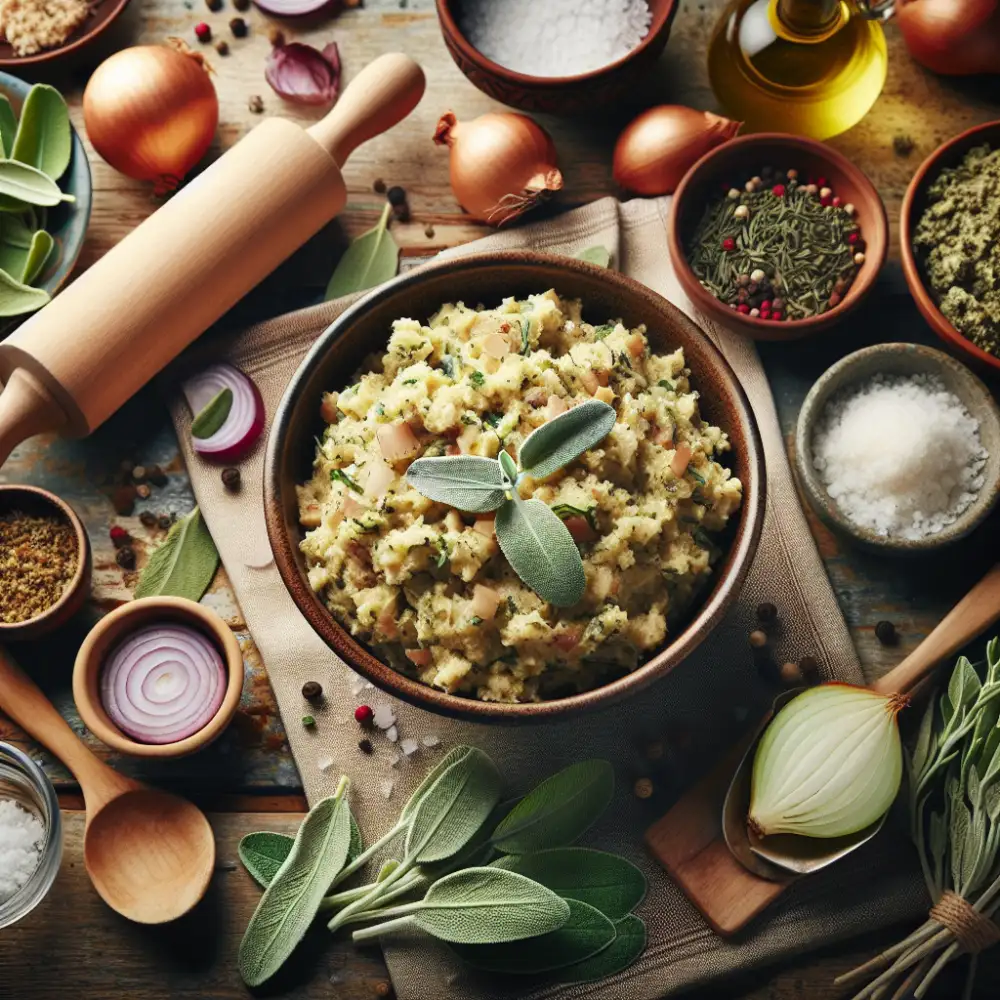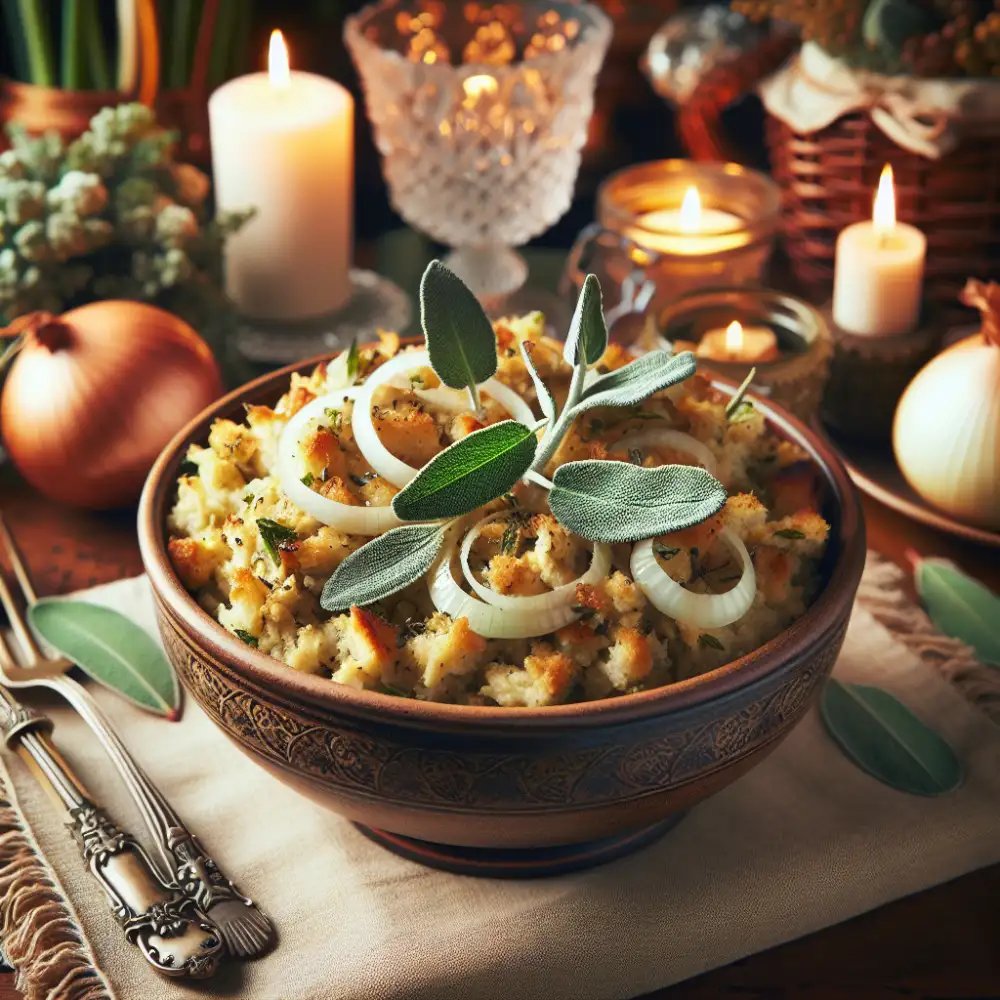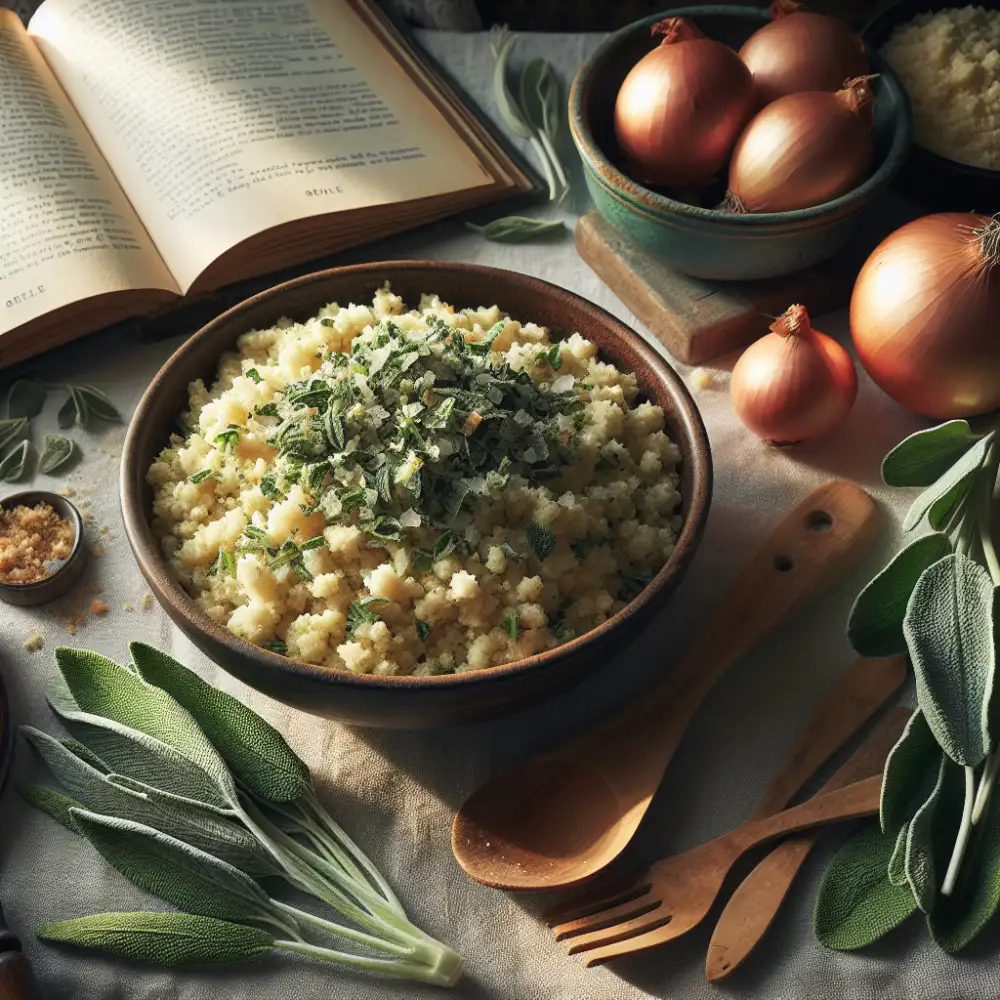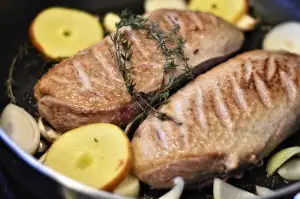Sage and Onion Stuffing: A Classic Recipe for a Flavorful Thanksgiving Feast

- History and Origins of Sage and Onion Stuffing
- Ingredients Required for Sage and Onion Stuffing
- Step-by-Step Instructions for Making Sage and Onion Stuffing
- Tips and Tricks for Perfect Sage and Onion Stuffing
- Serving Suggestions and Pairings for Sage and Onion Stuffing
- Health Benefits of Sage and Onion Stuffing
Sage and onion stuffing is a classic dish that has become synonymous with Thanksgiving feasts. This flavorful side dish adds a delicious twist to any holiday meal. The combination of aromatic sage and savory onions creates a mouthwatering blend of flavors that perfectly complements roasted meats, such as turkey or chicken. Whether you're hosting a traditional Thanksgiving dinner or simply looking to elevate your Sunday roast, sage and onion stuffing is sure to impress your guests with its rich taste and comforting aroma. In this article, we will explore the history, ingredients, preparation techniques, serving suggestions, health benefits, and more of this beloved culinary creation. Get ready to indulge in the timeless delight of sage and onion stuffing!
History and Origins of Sage and Onion Stuffing
Sage and onion stuffing is a classic dish that has been enjoyed for centuries. Its origins can be traced back to medieval times when it was commonly used to stuff poultry and other meats. The combination of sage and onion was believed to enhance the flavor of the meat and add a delicious aroma.
The use of sage in cooking can be traced back even further, to ancient Rome, where it was highly regarded for its medicinal properties. It was often used as a natural remedy for digestive issues and was believed to have cleansing properties.
Onions, on the other hand, have been cultivated for thousands of years and have been a staple ingredient in many cuisines around the world. They were valued for their versatility and ability to add depth of flavor to dishes.
The combination of sage and onion in stuffing became popular in England during the Middle Ages. It was traditionally used to stuff game birds such as pheasants or partridges, but over time it became a staple side dish for roast turkey, particularly during Thanksgiving celebrations.
Today, sage and onion stuffing remains a beloved part of holiday feasts in many English-speaking countries. Its rich history and comforting flavors continue to make it a favorite choice for those seeking a taste of tradition during festive occasions.
Ingredients Required for Sage and Onion Stuffing
To make a delicious sage and onion stuffing, you will need the following ingredients:
- Bread: Use stale bread or breadcrumbs as the base for your stuffing. You can choose white, whole wheat, or even cornbread depending on your preference.
- Onions: Finely chop 2-3 medium-sized onions to add a sweet and savory flavor to the stuffing.
- Fresh Sage: This aromatic herb is the star of the dish. You will need about 2 tablespoons of finely chopped fresh sage leaves.
- Butter: About 4 tablespoons of butter will help bind the ingredients together and add richness to the stuffing.
- Chicken or Vegetable Stock: Use around 1 cup of stock to moisten the mixture and enhance its flavor.
- Salt and Pepper: Season to taste with salt and pepper for a well-balanced flavor profile.
Optional Ingredients:

- Celery: For added crunch and freshness, you can include 1-2 stalks of celery, finely chopped.
- Garlic: If you're a garlic lover, mince 2 cloves of garlic for an extra layer of flavor.
- Nuts or Dried Fruits: Feel free to add some chopped nuts like walnuts or dried fruits such as cranberries or apricots for texture and sweetness.
Remember, these are just basic ingredients, and you can always customize your sage and onion stuffing based on your personal preferences and creativity in the kitchen!
| Feature | Traditional Recipe | Bread-Free Version |
|---|---|---|
| Primary Ingredient | Breadcrumbs | Quinoa/Rice/Cauliflower Rice |
| Gluten-Free Option | No | Yes |
| Dominant Flavors | Sage, Onion, Butter/Oil | Sage, Onion, Added Herbs & Spices (to taste) |
Step-by-Step Instructions for Making Sage and Onion Stuffing
1. Start by preheating your oven to 350°F (175°C) and greasing a baking dish.
2. In a large skillet, melt 4 tablespoons of butter over medium heat. Add 1 cup of finely chopped onions and cook until they become translucent, about 5 minutes.
3. Stir in 2 tablespoons of finely chopped fresh sage leaves and cook for an additional minute to release the flavors.
4. Remove the skillet from heat and let the mixture cool slightly.
5. In a large mixing bowl, combine 6 cups of stale bread cubes with the onion and sage mixture.
6. In a separate bowl, whisk together 1 cup of chicken or vegetable broth, 2 beaten eggs, 1 teaspoon of salt, and ½ teaspoon of black pepper.
7. Pour the liquid mixture over the bread cubes and gently toss until all the ingredients are well combined.
8. Transfer the stuffing mixture to the greased baking dish, spreading it out evenly.
9. Dot the top with small pieces of butter for added richness.
10. Cover the dish with aluminum foil and bake for 30 minutes. Then remove the foil and bake for an additional 15-20 minutes until golden brown on top.
11. Once done, remove from the oven and let it cool for a few minutes before serving alongside your Thanksgiving turkey or as a delicious side dish.
Enjoy your homemade sage and onion stuffing!
Tips and Tricks for Perfect Sage and Onion Stuffing
1. Use fresh ingredients: Opt for fresh sage leaves and onions to enhance the flavor of the stuffing.

2. Toast the bread: Toasting the bread cubes before adding them to the stuffing mixture will give it a nice crunch and prevent it from becoming soggy.
3. Properly season: Be generous with salt and pepper while seasoning the stuffing mixture, as it will bring out the flavors of the sage and onion.
4. Add moisture: To keep the stuffing moist, add some chicken or vegetable broth to the mixture. However, be careful not to make it too wet.
5. Mix well: Ensure that all ingredients are evenly distributed by thoroughly mixing them together before baking.
6. Adjust cooking time: Depending on your desired texture, you can bake the stuffing for a shorter time if you prefer it softer or longer if you want it crispy on top.
7. Let it rest: Allow the stuffing to rest for a few minutes after removing it from the oven before serving. This will help it set and make it easier to slice.
8. Experiment with flavors: Feel free to add other herbs or spices like thyme, rosemary, or garlic to customize your sage and onion stuffing according to your taste preferences.
By following these tips, you can create a perfect sage and onion stuffing that will impress your guests and elevate your Thanksgiving feast!
Serving Suggestions and Pairings for Sage and Onion Stuffing
Sage and onion stuffing is a versatile dish that pairs well with a variety of Thanksgiving favorites. Here are some serving suggestions to enhance your culinary experience:
- Traditional Roast Turkey: Sage and onion stuffing is a classic accompaniment to roast turkey. The savory flavors of the stuffing complement the succulent meat, creating a harmonious combination.
- Gravy: Serve sage and onion stuffing with a generous drizzle of homemade gravy. The rich, savory gravy adds depth to the dish, enhancing its flavors.
- Cranberry Sauce: The tartness of cranberry sauce provides a delightful contrast to the earthy flavors of sage and onion stuffing. The combination adds a burst of freshness to your Thanksgiving feast.
- Mashed Potatoes: Pairing sage and onion stuffing with creamy mashed potatoes creates a comforting and indulgent side dish. The contrasting textures and flavors make for a satisfying bite.
- Roasted Vegetables: Serve sage and onion stuffing alongside roasted vegetables such as carrots, parsnips, or Brussels sprouts. The sweetness of the vegetables complements the savory notes in the stuffing, creating a well-rounded meal.
- Green Salad: Balance out the richness of sage and onion stuffing by serving it with a crisp green salad dressed lightly with vinaigrette. The freshness of the salad provides a refreshing contrast to the hearty flavors.
Remember, these are just suggestions – feel free to experiment with different pairings based on your personal preferences. Enjoy the delicious flavors of sage and onion stuffing as part of your Thanksgiving feast!


Health Benefits of Sage and Onion Stuffing
Sage and onion stuffing not only adds incredible flavor to your Thanksgiving feast, but it also offers some surprising health benefits. Here are a few reasons why this classic dish is good for you:
- Rich in Antioxidants: Sage is packed with antioxidants that help protect your body against damage from harmful free radicals. These antioxidants can boost your immune system and reduce the risk of chronic diseases.
- Digestive Aid: Onions contain a compound called fructans, which acts as a prebiotic. Prebiotics promote the growth of beneficial bacteria in the gut, aiding digestion and improving overall gut health.
- Nutrient-Rich: Sage is an excellent source of vitamins such as vitamin K, which plays a crucial role in bone health and blood clotting. Onions are rich in vitamin C, which supports immune function, and various minerals like potassium and manganese.
- Anti-inflammatory Properties: Both sage and onions have anti-inflammatory properties due to their high content of flavonoids and other compounds. These properties may help reduce inflammation in the body and alleviate symptoms associated with conditions like arthritis.
- Heart Health: Onions contain compounds that can lower cholesterol levels and blood pressure, reducing the risk of heart disease. Additionally, sage has been shown to improve lipid profile by increasing "good" HDL cholesterol levels.
While sage and onion stuffing should be enjoyed in moderation due to its calorie content, these health benefits make it a worthwhile addition to your Thanksgiving table. So savor the flavors guilt-free knowing that you're also nourishing your body with beneficial nutrients.
Sage and onion stuffing has stood the test of time as a beloved classic in Thanksgiving feasts. Its rich, savory flavors and aromatic herbs add depth to any roast or poultry dish. This traditional recipe has been passed down through generations, originating from ancient Roman cuisine.
By combining simple ingredients like bread, onions, sage, butter, and stock, you can create a delectable side dish that will impress your guests. The step-by-step instructions ensure a foolproof result every time.

To enhance the flavors of sage and onion stuffing, consider adding other ingredients such as apples, cranberries, or walnuts for a touch of sweetness and crunch. Experiment with different herbs and spices to personalize your stuffing to suit your taste.
Aside from its delicious taste, sage and onion stuffing also offers health benefits. Sage is known for its antioxidant properties and may help improve digestion. Onions are packed with vitamins and minerals that support immune function.
Whether you're serving it alongside a roasted turkey or enjoying it as a vegetarian main course, sage and onion stuffing is sure to be a hit at your Thanksgiving table. So gather your loved ones, savor the classic flavors of this timeless dish, and create lasting memories together.
Published: 18. 02. 2024
Category: Food



